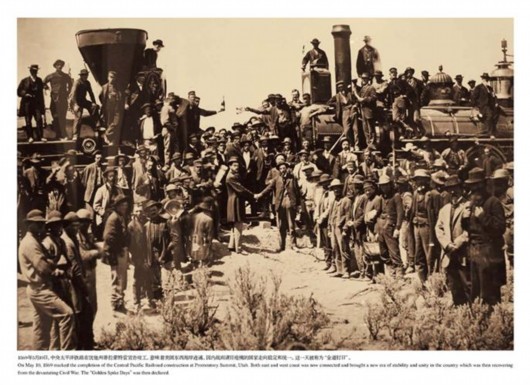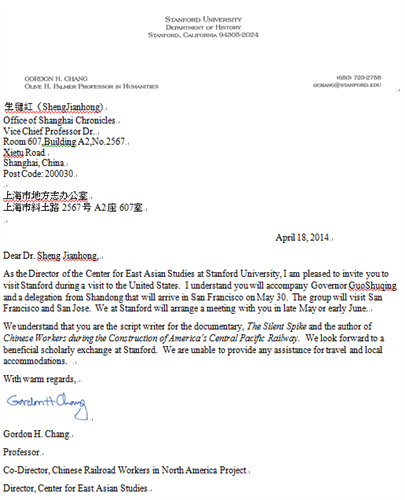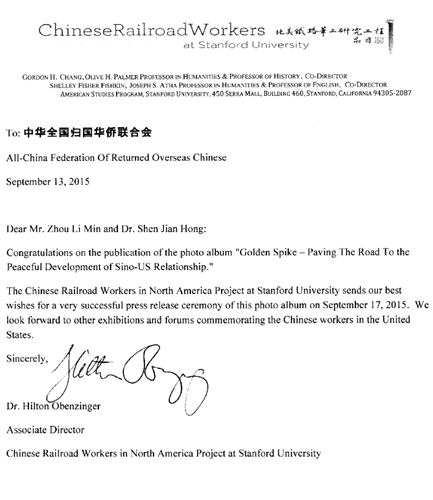Chinese President Xi Jinping’s visit to the United States becomes an instant hot recently. Xi arrived in Seattle on Sept. 22 with his wife Peng Liyuan, kicking off the 4-day state visit in the US. During the tour, Chinese President reached an important consensus on the construction of high-speed rail with the US. Cooperative construction of high-speed rail connecting the huge tourist city of Las Vegas and Los Angeles is expected to start at the end of September, 2016, making a turnaround of Chinese high-speed rail in the United States.
However, this is not for the first time that the two countries join hands on railroad construction. In 1869, a Golden Spike, full of Chinese railroad workers’ painstaking effort, was firmly embedded in the junction of the US Central Pacific and Union Pacific Railroads, becoming a powerful key to the modern development of both eastern and western coasts. Xi Jinping mentioned during the welcome dinner held by US overseas circle in Seattle that 150 years ago, together with American people, tens of thousands of Chinese workers built the transcontinental railroad, which carries not only the political and economic prosperity in the United States but also 150 years’ profound friendship between the two countries.
Reporter from Eastday.com recently exclusively interviews Sheng Jianhong who devotes herself to the research on Golden Spike. As a result, a touching story of China-US folk friendship appears in front of us.
——Editor

On May 10, 1869 marked the completion of the Central Pacific Railroad construction at Promontory Summit, Utah. Both east and west coast was now connected and brought a new era of stability and unity in the country which was then recovering from the devastating Civil War. The “Golden Spike Days” was then declared. (Photo provided by Zhou Limin)

Seminar invitation letter sent by Gordon H. Chang, Co-Director of Chinese Railroad Workers in North America Project and Director of Center for East Asian Studies, Stanford to Sheng Jianhong in April 2014

Dr. Hilton Obenzinger, Associate Director of Chinese Railroad Workers in North America Project at Stanford University sent a letter of congratulation.
Before entering the 6th floor’s conference room of Shanghai Chronicles Office to begin an interview with Sheng Jianhong, the author of Golden Spike – building up the road of peaceful development of China and the United States, I was nervous.
When I stepped into the room, I saw her standing in front of a row of scrolls, narrowing her eyes and staring at the hanging photographs showing the history of construction of the central Pacific railroad in a cherished way as if she was looking at her lover. Indeed, those are part of her fifteen years’ academic achievements. Sheng completed Chinese workers in the central Pacific railroad construction in May 2007, and reprinted it with some additions this year. She also published an album named Golden Spike – building up the road of peaceful development of China and the United States and made a scroll version of main content picked up from the album for the exhibition.
When she turned around, I saw a good-natured woman of the similar age with my mother. I suddenly felt relaxed a lot. She kindly greeted me.
To my surprise, Sheng hug my colleague coming along with me just like sisters. “How’s our cooperation?” “Go on according to the plan drawn up in May!” their conversation made me feel puzzled. But soon I learned that International Economy& Culture Exchange Center of Eastday.com has agreed on a cooperation scheme with the author of Golden Spike: a group of oriental angels led by Eastday.com will retrace the road of Gold Spike guided by the author. They will seek the history of Chinese workers coming to the US 150 years ago along the central Pacific railroad and pick up historic similarities between China Dreams and American Dreams in memory of profound friendship between Chinese and American people.
“I’m very sorry I’ve no Golden Spike in my hand currently as the album is pure manual printing and binding.” Said Sheng, 50 have been made for the premiere in Overseas Chinese History Museum of China co-held by All-China Federation of Returned overseas Chinese and Stanford University on Sept. 17. 200 books have been transferred to the United Nations as one of its conference materials on Sept. 26.
With no latest edition of Golden Spike in hand, we only appreciate the existing images and 50 picture scrolls for exhibition. Staring at those photographs, my thoughts went back to the California, Nevada and Utah in the United States 150 years ago.
Slowly, Sheng told us the story between her and the little-known history of 150 years ago.
Sheng studied in the United States fifteen years ago when she was the deputy dean of China-US Utah College of Science and Technology, Shanghai Normal University. As described in her translation book Nameless Builders of the Transcontinental Railroad and her monograph Chinese workers in the central Pacific railroad construction, Sheng’s research in the US got many friends’ help and support.
Carrying a backpack, two bottles of water and two breads, Sheng walked alone in the Utah desert only to explore the traces of history of the Chinese railroads workers…she had thought of giving up as it’s too hard with no historical data available for research. She got a runny nose in snow during the winter days and felt dizzy under the blazing sun in summer. “Just give up!” But when she thought of the difficulties faced by those Chinese workers 150 years ago, she continued. It’s these Chinese workers’ spirit inspired her to move on.
“I want to give them a justice as well as the honor they deserved. They were brave, smart and pioneer of us Chinese. I hope their descendants have the courage to admit them and been proud of them.” Sheng persisted in visiting descendants of those Chinese workers, talking to them and collecting historic resources. Utah gradually becomes her second hometown, where she has a lot of friends and cooperative research team.
In 2000, Elwood C·Zaugg, dean of Automotive College of Salt Lake Community College, Utah and his wife Elwood·Kay drove Sheng to National Historic Site—Golden Spike, kicking off her research on this subject. The Elwoods also told Sheng the story of deep friendship between Irish and Chinese workers during the hardship days constructing the transcontinental railroad especially in the difficult sections of the Sierra Nevada, Colorado Mountains. The couple still remained a small museum in the basement of their home, presenting tools and supplies used by their ancestors and Chinese workers. This little museum is 150-year deep friendship between Chinese and the US pioneers. According to historical records, about 2000 members of the Mormon worked along with Chinese laborers in the most difficult sections, forging deep folk friendship between different ethnic groups and religions. The Elwoods thought that Chinese workers were wisdom, gentle, industrious and brave. Yes, most descendants of those railroad workers are elites including outstanding aerospace engineers, doctors, professors, WW II military officers…
“My today’s achievement belongs to the whole research team due to their indispensable support.” It’s Sheng’s innermost thoughts and feelings.
Zhongxi Book Company, affiliated to Shanghai Century Publishing Group helped publish Golden Spike. General manager of the company Qin Zhihua selected their best and most efficient coordinating editors and art editors to deal with this major project with both significant academic value and social benefits. The most exquisite album finally came out after 21 days and nights of hard work.
Sheng was filled with a lot of feelings when referring to pictures using in the album. It turns out that these pictures were Zhou Limin’s 10-year painstaking achievements. Without any sponsors, Zhou even sold out his house in Jinan so as to continue his photographing plan along the central Pacific railroad. “I sincerely thank him,” Sheng spoke out excitedly.
Finally, Sheng took out a seminar invitation letter sent by Gordon H. Chang, Co-Director of Chinese Railroad Workers in North America Project and Director of Center for East Asian Studies, Stanford in April 2014 as well as photos at the scene of the seminar. Sheng thanked Chang’s excellent student Qi Shufang, PhD graduate from Stanford University for her volunteer help. Besides, Dr. Hilton Obenzinger, Associate Director of Chinese Railroad Workers in North America Project at Stanford University sent a letter of congratulation. All of these are supporting power for cooperative team preparing series activities commemorating the 150th anniversary of the central Pacific railroad
Series commemorating activities have already started. The golden spike was nailed at the moment of the completion of the Central Pacific Railroad construction, marking the deep folk friendship between China and the US. It’s not an ordinary spike but an affettuoso spike.
Endless stories of China-US friendship are behind the central Pacific railroad, we will follow the author to start our exploration.
At the end of the interview, Sheng got a scratchy throat and cannot speak a word. Long-term academic study made her feel exhausted. I have to stop today’s interview and only hope to get a Golden Spike in my hand as soon as possible.
稿件中文版:深情的道钉——专访《金色道钉》作者生键红
